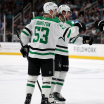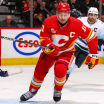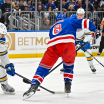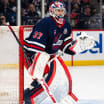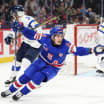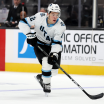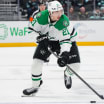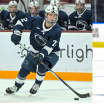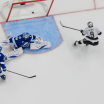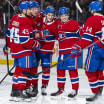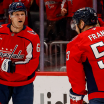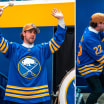BUFFALO -- They close their eyes, all at once. The 92 men and women are instructed to visualize an entrance that only two of them have ever made: Coming out of a dressing room, winding through the bowels of a building and finally skating onto the ice of an NHL arena for an NHL game. They can feel the adrenaline, the excitement, the want.
NHL grooming next generation of officials at Exposure Combine
Former players get taste of future as referees, linesmen at annual event
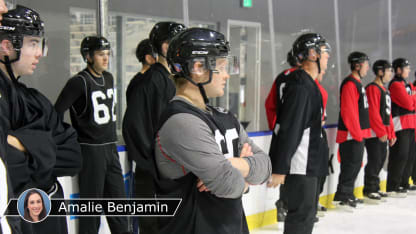
This is their ticket.
The Lexus Club at HarborCenter has been set up as a classroom, row upon row of chairs facing a video screen playing a snippet of what many of them hope is their future: Not as NHL players -- that dream has faded -- but as NHL officials, as referees and linesmen, a part of the game at the highest level that still seems within their grasp.
"I tell you, I got jitters," said David Broll, one of the few in the room to have had that experience as a player, having played five games for the Toronto Maple Leafs during the 2013-14 season.
He could feel it, again. They all could feel it.
The tingle. The jitters. Their future.
\\\\
It is a hot Thursday in August, months before the ponds even begin to think about freezing over, as 88 men and four women gather for what could be an opening to the rest of their lives. Some are convinced of the idea of becoming an official, having worked at the junior level for years. Some have never officiated a game and are unsure whether this path is for them. Most look like they just stepped off the ice, and many have, with sculpted bodies, high-and-tight cuts, and clean and casual style. They sit, easily, but there are nerves. They want to impress.
In turn, the men running this session want to impress them.
It is the fifth year of the NHL Exposure Combine, a close approximation to the NHL Scouting Combine. Each spring, player prospects from around the world come to Buffalo to take part in fitness testing and interviews ahead of the NHL Draft, meeting with the decision makers who could determine their future. They are tested and watched, their attributes broken down by a sea of scouts and front office personnel.
That all happens at the exposure combine too; the fitness testing includes the same vertical jump, standing long jump, bike testing and running drills. There, too, are the potential future bosses, representatives from leagues like the Western Hockey League and ECHL and the Quebec Major Junior Hockey League, evaluating those who could officiate their games one day.
It is where the search for the next generation of officials happens, with the NHL's senior vice president and director of officiating Stephen Walkom and Al Kimmel, director of scouting and development for officiating, playing the roles that the general managers and assistant GMs fill at the scouting combine.
Still, there is a relaxed feeling here, one that doesn't always come through at the scouting combine, an idea that there is fun to be had. There will be hockey games later, a tournament. There will be an event where the participants can de-stress and play cornhole and pickleball and try ropes courses, with beer in hand. They will be introduced, or reintroduced, to a profession that could provide a transition out of playing, that could keep them in the game, that could utilize the skills that they have worked for 20-plus years to hone. They will be sold on this life as Walkom and his team attempt to persuade them that the image of officials is changing, that they want to be among that group.
"If we're going to increase the supply of officials throughout North America and the world, then we have to go to the people who love hockey, and that's people who played hockey," Walkom says.
These are those people.
More videos play on the screen, shots of NHL hockey, goals scored, passes made. The focus is on the players, on the plays. The officials are incidental, a glimpse here, a black-and-white smudge entering the periphery of the image.
Walkom acknowledges what they all know, what these hopefuls are doing in this room as summer wanes and hockey season approaches.
"The game," Walkom says, "it's why we're here."
\\\\
Their system wasn't working.
The NHL had been bringing potential officials to Toronto for years, polling coaches and scouts and player development people to find options. But it seldom worked out. Those candidates rarely ended up reaching the highest levels. Instead, the new hires continued to be people who played as kids, who started working in the system early, slowly climbing the ranks, eventually graduating.
That wasn't good enough for Walkom.
"Years ago, we looked at the attributes of guys that had had great careers in the National Hockey League and two of the main things that came out of it was the guys that had had the longest and best careers were generally great skaters," Walkom said. "They could always keep up with the pace of the NHL game. And secondly, they had a real hockey IQ."
The trick was to uncover enough of them, something that was becoming a pressing issue, especially after the NHL adopted the four-man officiating system for the 2000-01 season, which other leagues (including the American Hockey League) have done recently.
"We did see a shortfall in the supply of officials everywhere," Kimmel said. "Young people weren't getting involved in officiating, frustrated with different aspects of the game, abuse from coaches, from parents. So Stephen Walkom thought, what's a good resource we can use? And what better avenue than people that have played the game."
But it wasn't just about finding and identifying those people. Once they were found, it was about convincing them that they should go into officiating, rather than coaching or player development or scouting. Because, as Kimmel put it, "Five years ago it wasn't a really cool thing. I mean, it's never been a cool thing to be an official."
So they ramped up their operation, molding it into a facsimile of an NHL front office, knowing that, though they didn't have the benefit of an organized draft, they could do the rest, the locating and the scouting and the recruiting. They could shape the players they saw into the officials they wanted.
Thus, in 2014, the NHL Exposure Combine was born.
It was a two-pronged approach, with prospects and current and former players attending in even-numbered years, including 2018, and amateur types about 15 to 18 years old in odd-numbered years. They would introduce the concept and follow up. They would take raw, untested men and women who had the necessary skating skills and fitness skills and hockey minds and convince them that this was a valid career path. This was where they wanted to be.
The first year, 52 people attended, and it wasn't easy to get even that many.
"Everybody that applied was accepted," Kimmel said. "I wrote to 300 schools and all the juniors leagues, just trying to get participants. This year, after four years, people are flocking to us. We had over 300 applicants and we had to turn 200 people away that want to be involved."
He added, "The first year, three-quarters of them couldn't cut it and a quarter were studs. I think now this year, three-quarters are studs and there's a few who don't belong. That's the difference of five years."
That is good news for them, for the future of officiating, at all levels. Eighteen of the participants have segued into careers as NHL officials, and 12 of them are now full-time in the League, including linesmen Shandor Alphonso and Ryan Gibbons from the first combine in 2014.
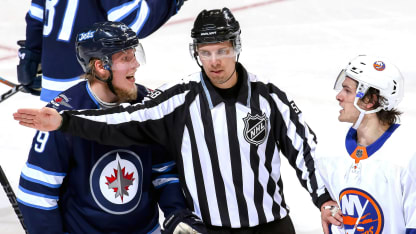
© Jonathan Kozub/Getty Images
"I spent 20 years or so with the scouting side of it, and we're operating exactly the same way the teams are now, which didn't happen before," NHL officiating manager Chris Edwards said. "We're really looking; we're considering this as draft picks.
"The bottom line is we've built into a real professional operation. The scouting and the development of the officials, it's just as important. It's something that I don't think a lot of people really realize how much money and resources are poured into this."
There are officiating managers that work with the top-level officials, and scouts across the minor leagues and midseason meetings and year-end meetings and discussions and debate. There is projection, finding not just the sure-thing prospects, the Connor McDavids and the Auston Matthews of officiating, but the late-rounders, the Jamie Benns and the Henrik Zetterbergs.
"It's not necessarily the best guy today," Kimmel said. "But where people can be in the future."
\\\\
It is 12:07 p.m. on Friday, the first full day of camp, and the last CLIF bar has just been snagged. This morning's Gatorade delivery arrived without any protein bars, forcing Taryn Daneman, coordinator of NHL officiating, to make a Target run. She returned with $400 worth, a stash of KIND and CLIF bars that will barely make it to the afternoon of the first day.
They are set out on a counter not far from the "Yo-Yo" test that has been bedeviling the participants all morning. Much like a more traditional beep test, it helps measure a player's aerobic fitness and endurance as each person runs from cone to cone within a series of beeps. The testing has alternately elicited cheers and groans from the crowd, as those who spent their summers training are rewarded and those who spent it drinking too many beers are not.
It has also elicited comparisons between the participants.
"I think it's human nature for people to gauge themselves against other people," said 21-year-old Matt Ceko, who also attended the first exposure combine for teenagers in 2015. "It's what humans have been doing [from a] basic evolutionary standpoint. So it's hard fighting my evolutionary standpoint."
Fitness is a crucial piece of the puzzle for the officiating managers, along with the skating skills and the feel for the game. Endurance and physicality have become ever more important as the speed of the game and athleticism have increased. The officials cannot be left behind.
"Every official needs to realize if they want to progress through the system or be part of the system, they need to strive to be in the same physical condition and have the same skillset skating as the athletes they want to officiate," said Kevin Muench, senior director of officiating for the WHL.
But it is not all about the fitness at the combine. With the testing and on-ice fundamentals -- dropping the puck, face-offs, icings -- nearly completed, it's time for the fun part.
The games are about to begin.
It's ingenious, in a way. The combine gets the referee hopefuls out on the ice, most of them with sticks in hand. It puts them where they are happy and relaxed, where they have spent most of their lives, with some playing and the others officiating. Those new to officiating are paired with prospects, some that have spent at least a year in the trenches and who have shown promise, allowing the talent evaluators a chance to see them, to see their hockey minds and their skating chops and their comfort level.
Because, as Walkom said, "Maybe this is the crux of it all: If you have a hard time playing recreational hockey, then it's going to be very difficult for you to officiate a high level of hockey."
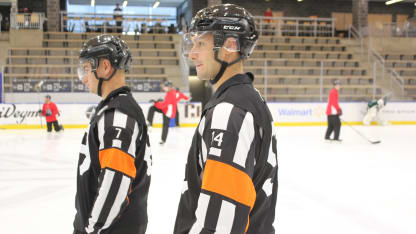
The games are sometimes messy affairs, given the disparate hockey abilities. There are hooks that go uncalled and offside calls that are maybe too aggressive. Someone misses a blatant too-many-men-on-the-ice penalty, and someone else gets whacked in the face, leaving a lump that will have former NHL player Mike Duco steaming for the rest of the night and earn him merciless teasing.
They also give the participants a chance to see a tiny approximation of what life might be like on the other side, on the other team, wearing the stripes. Whether they like it or not.
"I remember this one person came up to me at the end of the combine and he goes, 'You know, the combine was great, I really enjoyed it. It was a lot of fun, but one thing that it's really taught me is that I never want to officiate,'" Walkom said.
That reaction works too. It's not going to be for everybody.
"It's hard," Walkom said. "It's harder than ever now because it's so competitive. … I say to people it's hard but it's worth it if you make it. Some people don't make the NHL but they're great in the American Hockey League. Some people don't make the American Hockey League but are good in the USHL or major junior. There's always room in hockey."
\\\\
It is notable to see the differences between the attendees at the combine. Some are all in; they already have been convinced that officiating is their career path, that this is their future and the way to the NHL. Others are warier, unwilling to commit, even after spending a summer weekend here to understand the role.
The trick is to make sure there are more of the former than the latter. It's to make sure that officiating is seen as just as valid a career path as coaching or scouting for an ex-player, even if not the sexiest of choices.
And that comes with education and understanding, and with a new generation of officials who do not fit into any of the stereotypes that might be floating around.
"There's a certain image of officiating that is out there, it's a person that never played hockey, someone that's out of shape and someone that can't skate," Walkom told the group at the opening session. "For us in the game of hockey, how do we change that? How do we change the perception or the image? The only way to change that is to have likeminded people officiating, that are athletic, love hockey, and played the game at a real high level. That's the way you change."
That's why it's significant for Edwards that he has started to be approached by players. It happened this past season when Broll, a forward for Laval of the AHL, was scratched for a game in Belleville, Ontario, where Edwards is based. Broll, having first seen the combine mentioned on the Professional Hockey Players' Association website, sat with Edwards for a period. He asked questions. They discussed the options and the future.
Broll ended up in Buffalo, with a few for-fun games as an official under his belt and, as he put it, "a little more respect for the role and job."
He's not done playing, not yet. But officiating is on his radar, where in the past he might never have considered it at all.
"Coaches and parents in the game of hockey need to realize that if they ever expect officiating to improve at levels from the NHL on down, it's important that those players that are sitting on the bench, when they're done playing hockey, try officiating," Walkom said. "It's vital to the long-term success of the game."
\\\\
Conor O'Donnell had planned to play in the NHL. He never had considered officiating.
"I came to the camp not expecting much, to be honest," he said.
O'Donnell arrived at the 2016 combine in the best shape of his life, with one final season of playing in the ECHL ahead of him. He was intrigued by the weekend, by the idea of still getting to the NHL. He was invited, having never officiated a game, to the Toronto Maple Leafs rookie tournament, "my first time ever stepping onto the ice, putting on a ref jersey."
A week after that, he was officiating in the AHL.
That's how fast it can happen. That's the carrot.
"A lot of them have the physical skillset, and basically we have to teach them officiating concepts, which doesn't take long to grasp," Kimmel said. "People we took a year ago that had no experience whatsoever, put them into American League games and after 20 or 30 games, [they] pick up on all the officiating concepts and turn into very competent officials by the end of the season."
There are some things that can be taught. Some that cannot.
But while taking and molding ex-players into officials is the new path, the one that Walkom and Kimmel have pioneered and pushed, it is not the only one for those attending the combine. Ceko, who attended the inaugural amateur combine in 2015 when he was 18, first tried officiating at 15 because, as he said, "it beat working at McDonalds." He had played junior hockey and wanted to get a different perspective on the game.
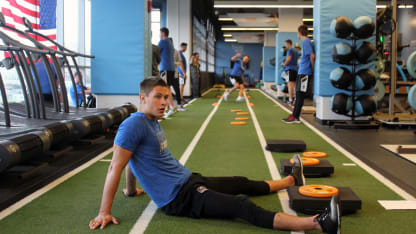
"You never know where it can take you," said Ceko, who will officiate in the Ontario Hockey League and ECHL this season. "It's a surreal experience. Come here, you're a sponge, you soak everything up and you put your best foot forward."
Ceko, at one point last season, was officiating a game in Elmira, New York, and looked up into the stands. There was Kimmel, watching him, scouting him. He got nervous. He might have blown an offside call, he thinks.
Kimmel doesn't remember it that way.
But Ceko knew that part of his future might depend on what he did the rest of the game, how much he might impress the man in the stands with the power to push him to a place he never would have otherwise achieved.
"I went back to the dressing room, just, 'Matt, you're here, you've been working for this moment. Just go out and do what you can do,'" Ceko recalled. "That's all you can ask for is to go out and do your job. … That's what the coaches want. It's what the players want. It's what the fans want. You just want to get it right."
\\\\
It is the final day of the combine. The protein bars are eaten; the bags are packed; the tournament winner has been crowned. One hundred and 10 boxed lunches await, and the participants will pile into their cars and onto airplanes, out of Buffalo and on their way home.
Some of them will leave just as unconvinced as they arrived. Some will have had their minds changed. Some will be as giddy about the opportunity as they were when they pulled up to HarborCenter. Some will have proven themselves, enough for an AHL contract this season, perhaps a 40-40 -- 40 games in the AHL, 40 in the NHL -- next season, perhaps a full-time gig in the NHL the following season. Four or five have been identified as having particularly high ceilings.
Five years in, the combine is producing what it was designed to produce: the officials who will take the ice for the next five or 10 or 20 years in the NHL, the AHL, the ECHL, the WHL, the youth games throughout the United States and Canada. It has produced officials like Alphonso, who came back this year to work with the newbies, as current referee Wes McCauley and current linesman Scott Cherrey did for him.
"I remember just being in awe," said Alphonso, who had spent four years officiating in the OHL prior to coming to the first combine. "Because you're watching the Stanley Cup Final and those guys are on the ice, then they're here talking to you, so it was cool."
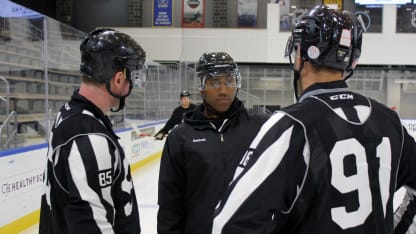
That's the image they want to project. That's what Walkom and his crew hope that at least a few of their prospects will walk out of HarborCenter feeling. That awe. That veneration of a job that they think can be better than it is now, that can attract better talent and better prospects, as they plan for a future in which they will see a higher amount of turnover than usual.
"We're just looking for the best people," Kimmel said. "That's all we can afford to take now. It's the highest level and we have to really be sure of who we bring upward."
Some current NHL officials are nearing the end of their careers, and 36 positions already have changed hands in the NHL and AHL since 2014.
Now, with the combine, they have succession planning. An officiating manager will sit down with a current official to come up with an idea of when they might step down. That way they can plan. They can look for a replacement, with the ability to train and prepare him for what might be ahead.
"Stephen brought that in, just running it like a business and a tuned organization, just like the teams, where year after year we have draft picks coming in to replace the veterans," Kimmel said. "Now we can afford to be choosy."
There is no more panic with hiring. Walkom and his staff can take their time. They can develop the next generation. They can persuade them that wearing the stripes is the next step for them. They can turn O'Donnell and Broll from skeptics to converts over the course of a weekend, a summer, a season.
They can make sure that when the participants leave Buffalo, head back to their homes and their playing careers and their lives, they have seen what this means, how they might fit into the world of officiating.
Their eyes, now, are fully open.

